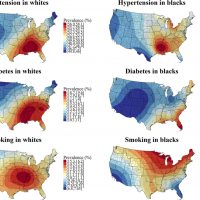Maps in new UNC-led study show each state’s stroke risk factors at a glance
February 8, 2017
A new study led by a University of North Carolina at Chapel Hill researcher has produced data-rich maps of the United States that show the geographic distribution of key stroke-causing factors, and one region stands out more than others.
The study, “Heat Maps of Hypertension, Diabetes Mellitus and Smoking in the Continental United States,” appeared in a recent issue of the journal Circulation: Cardiovascular Quality and Outcomes, and was led by Matthew Shane Loop, PhD, assistant professor of biostatistics at UNC’s Gillings School of Global Public Health.
On the maps, the Southeast, especially the states of Alabama, Georgia, Louisiana, Mississippi and Tennessee, display some of the highest prevalence of hypertension and diabetes among whites and blacks.
Loop and his colleagues used data produced by the National Institute of Health’s (NIH) Reasons for Geographic and Racial Differences in Stroke (REGARDS) population health study to graphically map the concentrations of three key risk factors for stroke – hypertension, diabetes and smoking – producing a kind of “Doppler radar” of the prevalence of these risk factors. The risk factors also are differentiated into white and black populations.

Shown are maps of estimated hypertension, diabetes mellitus and current smoking prevalence among whites and blacks, adjusted for age and sex.
The data, collected between 2003 and 2007, were from both male and female participants who were 45 years of age or older. The participants also were differentiated by white and black race to account for potential racial disparities.
“These maps reveal a level of detail in geographic disparities in stroke risk factors that we did not have before,” Loop said. “The maps can be used by other scientists interested in geographic disparities, and hopefully will aid one of the most important goals of public health — prevention of disease.”
Black adults in the study presented with higher prevalence of risk factors than whites overall. Specifically, hypertension averaged 72 percent among blacks and 49 percent among whites, and diabetes averaged 31 percent in blacks versus 14 percent in whites. Smoking was a bit closer in its distribution, averaging 18 percent among blacks versus 12 percent for whites. While the first two factors were seen most commonly in the Southeast, the prevalence of smoking was actually higher in the Midwest.
“There might be more variation in the presence of these risk factors in the South than we previously though, which could lead to more focused public health efforts,” Loop added.
The full study can be found here.
Share
Gillings School of Global Public Health contact: David Pesci, director of communications, (919) 962-2600 or dpesci@unc.edu

